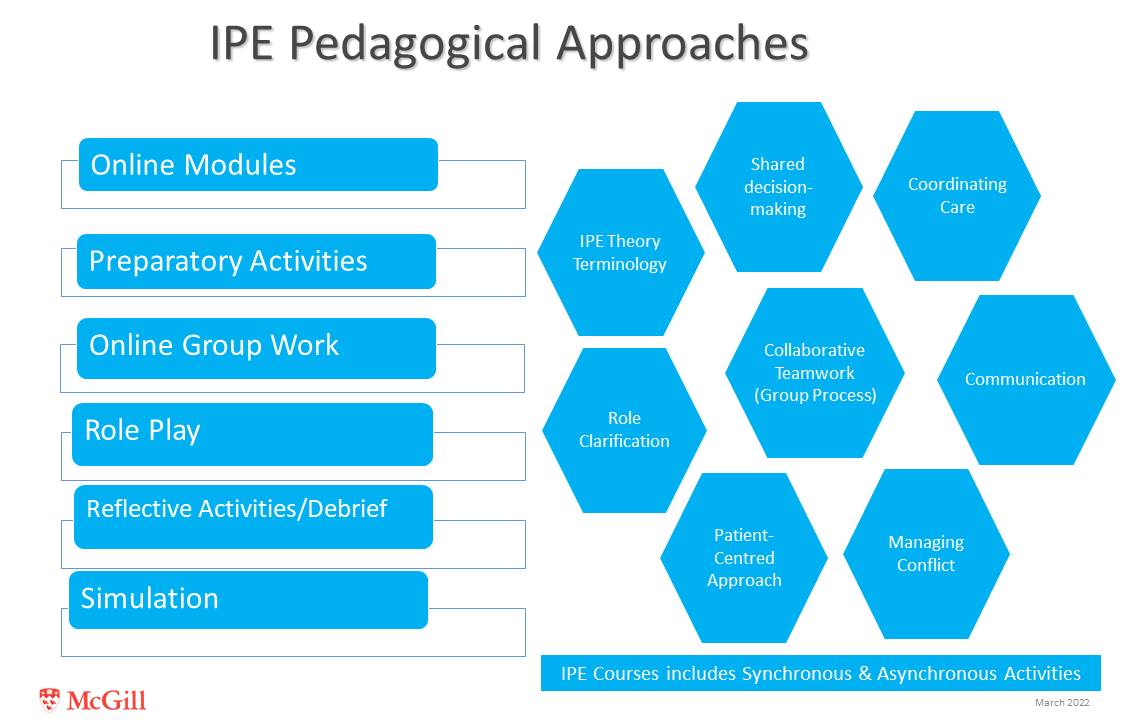
The IPE curriculum is grounded on principles of constructivism including socio-cultural constructivism in which learning results from the student’s interaction with the instructional environment comprising the instructional activities and the interprofessional (social) groups or community of learners. The socio-cultural environment enables students to appreciate alternative and congruent views and perspectives on client care from different healthcare professionals that in turn fosters reflection on their own knowledge and professional philosophies (Hean et al., 2009). The socio-cultural learning environment also creates a sense of collective belonging to the healthcare community thereby fostering a cohesive vision for patient and family centred care. The use of a case-based approach (CBL) affords students a shared learning experience (Thistlethwaite et al., 2012). In addition, social collaborative problem solving fosters a collective interpretation and reflection on learning and facilitates a shift in the learner role from a passive recipient to that of explorer, producer, communicator, and collaborator (Driscoll, 2005; Vygotsky 1978). Shared learning opportunities through intentional group reflections capture a group or team’s ability to reflect on group objectives, strategies, processes, and outcomes of current performance and consider ways of adapting in future practices (Schmutz & Eppich, 2017).
Knowledge is also constructed as students are active participants in the instructional activities, both prior to the IPE activity and during using a flipped classroom approach. The constructive cognitive process is elicited through selected instructional methods (e.g. self-directed on-line modules and videos requiring reflective written responses (individual or group) that are then followed up with in class or online interactive group work and discussions, quizzes, role play and simulation experiences using authentic cases). The opportunity to collaboratively engage in case-based learning (CBL) within each of the interprofessional education courses enables students to further develop and clarify their own professional role through role play, collaborative team problem solving or simulation. Through participation in the flipped classroom and CBL students become engaged in the learning process and acquire a sense of ownership and accountability for their participation and their learning with, from, and about each other. Case Based Learning places the emphasis on the development of a reflective practitioner by enabling the student to explore and solve problems. It engages students in the discussion of specific situations that are based on real-world examples.
Active learning is enhanced by aligning students’ learning needs with: a) the instructional context and approach (flipped classroom, CBL (b) the activities (e.g., preparatory online modules, problem solving through group collaboration and shared decision making, simulation with standardized actors and professionals, reflective debriefs); and c) the learning outcomes of each IPEA course which are based on the CIHC (2010) competencies.
Formative feedback is integrated into the learning experience and provided by facilitators (i.e., Faculty Members, Clinicians or Medical Residents), and peers following a simulation of teamwork in action, collaborative brainstorming activities or group discussion. Small group discussions are guided by facilitators from two different professions, providing an opportunity to model and foster interprofessional collaboration.
Each IPEA course integrates different pedagogical approaches to provide students with a unique opportunity to learn from, with, and about each other’s profession.